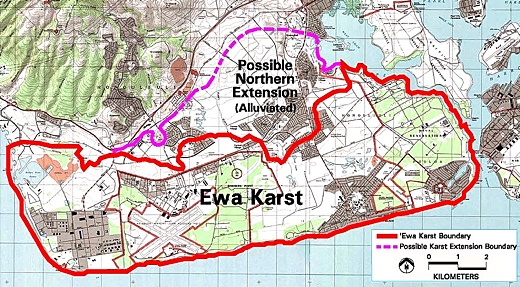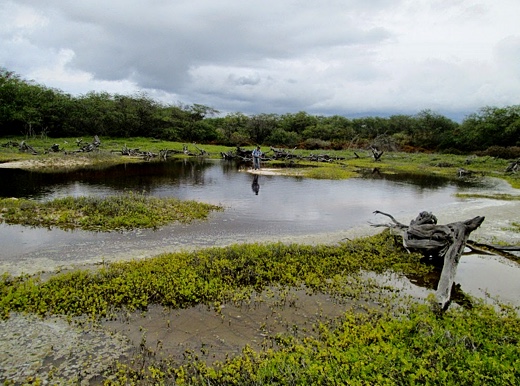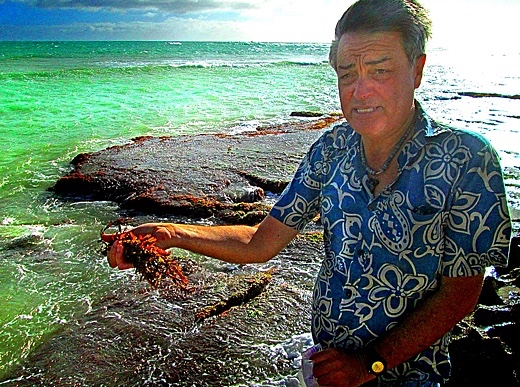SUBHEAD: Navy refuses native Hawaiian practitioner rights in secret Ewa, Oahu, land transfer. Complaint filed with state and federal agencies.
By Michael Lee on 6 September 2015 in Kanahili Blogspot -
(http://kanehili.blogspot.com/2015/09/navy-refuses-native-hawaiian-rights.html)

Image above: Area of the Ewa karst west of Pearl Harbor. Note multiple military and industrial installations already impacting this sensitive unique environment. Click to embiggen. From original article..
With regards to the secretive Navy land transfer of many parcels of lands which exist on the plain of Kaupe’a and Kanehili, Honouliuli ahupua’a moku of Ewa, identified previously as the former Navy Barbers Point Air Base and today is called Kalaeloa.
As a recognized Native Hawaiian cultural practitioner in Honouliuli, Ewa, by the Board of Land and Natural Resources, the 1st Circuit Court, Intermediate Court of Appeals, as a HART Programmatic Agreement Consulting Party, as a Navy KREP PV Farm Consulting Party, as well as a recognized cultural descendant on April 14, 2010 by the O’ahu Island Burial Council to ancestral native Hawaiian remains within and surrounding the Navy lands of Barbers Point, Iroquois Point and West Loch, I provide the following statement:
I must rely upon vigilant protection of my religious, traditional and customary Native Hawaiian practices, cultural and natural resources or I and the Hawaiian people will lose them forever.
As the kahu, or keeper, of the iwi kupuna in this area, as recognized by the Oahu Island Burial Council and State of Hawaii Historic Preservation Division, it is my responsibility to ensure the protection and safety of all the ancestral bones and funerary objects within in this area of my responsibility. I can and have filed lawsuits and won when my cultural rights have been damaged and violated.
I have to ask: Why was I not consulted in this land transfer which directly concerns my cultural practice and the tens of thousands of iwi kapuna in the Leina a ka uhane that I have responsibility to protect?
I am also an Hawaiian astronomer or star priest called Papakilohoku recognized by the Honolulu City Council with an Honorary Certificate and also very recently consulted by astronomy organizations on the Big Island regarding native Hawaiian astronomy.
All this background gives me standing concerning the Federally recognized Hawaiian Traditional Cultural Property (TCP) in Honouliuli called the Leina a ka Uhane, a very sacred spiritual leaping place for souls of the deceased returning to their ancient homeland.
This major wahi pana (sacred place) was Federally recognized by the HART Rail Project in a 2012 published series of documents as a Section 106 requirement to identify Ewa Plain Honouliuli TCP’s.
The Leina a ka Uhane TCP is clearly within the same ancient area known as the Plain of Kanehili and Plain of Kaupe’a, connected by the important ancient Hawaiian trail system within Honouliuli-Ewa identified by the 1825 Malden Trails map. All of this was also well identified in numerous Navy base closure documents and maps produced in 1979 through 2001.
Leina a ka Uhane in Kanehili is a sacred burial area for iwi kupuna in the tens of thousands. There is no excuse for the Navy land transfer to completely ignore all of this Federally produced Leina a ka Uhane TCP documentation and not consult with the most qualified and widely recognized resident Kahu in Honouliuli, Ewa.
The Navy lands being transferred are only minutes away from where I live and I have walked through it many times. The presence of burial sites, ancient habitation sites and the spirits of my ancestors is very real there and these spirits of the iwi kupuna call to me for their protection to prevent their desecration.
Burials in the Plains of Kanehili and Kaupe’a areas using the native Hawaiian Trails drawn by Malden in 1825 and subsequently documented by archeologists for the Navy in detailed archeological reports as on the Barbers Point Navy Base and Ewa Marine Air Base cannot be denied. These are facts but the Navy is intentionally ignoring them in the land transfer.

Image above: Wetlands on the Ewa Karst are delicate and of sacred importance to Hawaiian culture. From original article.
The ancient Hawaiian trails running from Honouliuli to Ewa, Palehua, Kualaka’i and One’ula are very key components for understanding the cultural history of the Honouliuli ahupua’a. Portions of these trails still exist through the Plains of Kaupe’a and Kanehili, in the foothills by Makakilo which was a major Papakilohoku star priest observation place, and in the documented archeological trails and iwi kupuna Karst burial areas which exist in the Barbers Point Navy lands being transferred.
This Navy land transfer is an attempt to evade native Hawaiian cultural rights as specified in numerous State and federal laws protecting native Hawaiian culture.
The US Navy is intentionally allowing, by their secrecy and lack of consultation with the most qualified local native Hawaiian residents, this most significant sacred cultural landscape in the Hawaiian Islands. This lack of cultural respect has and will cause great emotional and spiritual harm to not only myself, but to thousands of the cultural descendants of the iwi kupuna buried in there. This harm extends to the spiritual well-being of the entire Native Hawaiian lahui as well.
As a long time kahunalapa’auokekaiolimu, or Native Hawaiian practitioner of limu medicine, I have standing under Hawaii law protecting Native Hawaiian cultural practitioners and I am recognized in the Hawaii First Circuit Court in cases for the Honouliuli area and in Federal Court as the Hawaiian Cultural Practitioner of sea medicine on the Big Island in Kohala in the Kona Blue v. Kahea Kohala fishery's case in 2011.
The entire Plain of Kaupe’a and Kanehili are entirely ancient coral limestone reef with thousands of caves and sinkholes. This is a well documented fact by the Navy’s own base closure archeologists.
Fresh water flows through an extensive network of underground interconnected Karst caverns and channels from the mountains to the sea in the Plain of Kaupe’a and Kanehili which contains the nutrients that feed our eco-system food chain.
The Honolulu City Council passed unanimously in 2012 the Ewa Plain Trails resolution giving my cultural practice further standing in Honouliuli by advocating the protection of the 1825 Malden Trails (ancient Hawaiian trails) and Ewa Karst water system which is an ancient limestone reef wetlands water system.
I believe it is my duty as a native Hawaiian cultural practitioner to state that we cannot afford any more of these losses and developments must adhere to state and federal laws. This is also a Hawaii Public Trust Interest as stated in the Hawaii State Constitution. The State of Hawaii is mandated to protect this resource- caves, karst, underground streams and rivers under Statute 6D 1-10, Article 11, Section 7 State Constitution.

Image above: Author Michael Lee at shoreline of Ewa Karst holding native seaweed. From original article.
Native Hawaiian TCP’s do not follow any exact linear, circular or simple place box format like a TMK. They can cover a large area, vary in depth and width and are often linked together by trails, caves, ponds and canoe landings. The land and the people are one.
Access to and protection of native cultural sites and ecosystems is a cornerstone of recognized cultural practice in Hawai‘i. When a sacred place, native species or critical ecosystem is lost, a wahi pani or wahi kapu is erased from the landscape, the words and traditions associated with them are also lost.
Native Hawaiian rights: Article XII Section 7 of the Hawaii Constitution states, "The State reaffirms and shall protect all rights, customarily and traditionally exercised for subsistence cultural and religious purposes and possessed by ahupua'a tenants who are descendants of native Hawaiians prior to 1778."
CONTACT:
Michael Lee
91-1200 Keauniu Drive, Unit 614,
Ewa Beach, Hawaii 96706
kanehilivideos@gmail.com
.
By Michael Lee on 6 September 2015 in Kanahili Blogspot -
(http://kanehili.blogspot.com/2015/09/navy-refuses-native-hawaiian-rights.html)

Image above: Area of the Ewa karst west of Pearl Harbor. Note multiple military and industrial installations already impacting this sensitive unique environment. Click to embiggen. From original article..
With regards to the secretive Navy land transfer of many parcels of lands which exist on the plain of Kaupe’a and Kanehili, Honouliuli ahupua’a moku of Ewa, identified previously as the former Navy Barbers Point Air Base and today is called Kalaeloa.
As a recognized Native Hawaiian cultural practitioner in Honouliuli, Ewa, by the Board of Land and Natural Resources, the 1st Circuit Court, Intermediate Court of Appeals, as a HART Programmatic Agreement Consulting Party, as a Navy KREP PV Farm Consulting Party, as well as a recognized cultural descendant on April 14, 2010 by the O’ahu Island Burial Council to ancestral native Hawaiian remains within and surrounding the Navy lands of Barbers Point, Iroquois Point and West Loch, I provide the following statement:
I must rely upon vigilant protection of my religious, traditional and customary Native Hawaiian practices, cultural and natural resources or I and the Hawaiian people will lose them forever.
As the kahu, or keeper, of the iwi kupuna in this area, as recognized by the Oahu Island Burial Council and State of Hawaii Historic Preservation Division, it is my responsibility to ensure the protection and safety of all the ancestral bones and funerary objects within in this area of my responsibility. I can and have filed lawsuits and won when my cultural rights have been damaged and violated.
I have to ask: Why was I not consulted in this land transfer which directly concerns my cultural practice and the tens of thousands of iwi kapuna in the Leina a ka uhane that I have responsibility to protect?
I am also an Hawaiian astronomer or star priest called Papakilohoku recognized by the Honolulu City Council with an Honorary Certificate and also very recently consulted by astronomy organizations on the Big Island regarding native Hawaiian astronomy.
All this background gives me standing concerning the Federally recognized Hawaiian Traditional Cultural Property (TCP) in Honouliuli called the Leina a ka Uhane, a very sacred spiritual leaping place for souls of the deceased returning to their ancient homeland.
This major wahi pana (sacred place) was Federally recognized by the HART Rail Project in a 2012 published series of documents as a Section 106 requirement to identify Ewa Plain Honouliuli TCP’s.
The Leina a ka Uhane TCP is clearly within the same ancient area known as the Plain of Kanehili and Plain of Kaupe’a, connected by the important ancient Hawaiian trail system within Honouliuli-Ewa identified by the 1825 Malden Trails map. All of this was also well identified in numerous Navy base closure documents and maps produced in 1979 through 2001.
Leina a ka Uhane in Kanehili is a sacred burial area for iwi kupuna in the tens of thousands. There is no excuse for the Navy land transfer to completely ignore all of this Federally produced Leina a ka Uhane TCP documentation and not consult with the most qualified and widely recognized resident Kahu in Honouliuli, Ewa.
The Navy lands being transferred are only minutes away from where I live and I have walked through it many times. The presence of burial sites, ancient habitation sites and the spirits of my ancestors is very real there and these spirits of the iwi kupuna call to me for their protection to prevent their desecration.
Burials in the Plains of Kanehili and Kaupe’a areas using the native Hawaiian Trails drawn by Malden in 1825 and subsequently documented by archeologists for the Navy in detailed archeological reports as on the Barbers Point Navy Base and Ewa Marine Air Base cannot be denied. These are facts but the Navy is intentionally ignoring them in the land transfer.

Image above: Wetlands on the Ewa Karst are delicate and of sacred importance to Hawaiian culture. From original article.
The ancient Hawaiian trails running from Honouliuli to Ewa, Palehua, Kualaka’i and One’ula are very key components for understanding the cultural history of the Honouliuli ahupua’a. Portions of these trails still exist through the Plains of Kaupe’a and Kanehili, in the foothills by Makakilo which was a major Papakilohoku star priest observation place, and in the documented archeological trails and iwi kupuna Karst burial areas which exist in the Barbers Point Navy lands being transferred.
This Navy land transfer is an attempt to evade native Hawaiian cultural rights as specified in numerous State and federal laws protecting native Hawaiian culture.
The US Navy is intentionally allowing, by their secrecy and lack of consultation with the most qualified local native Hawaiian residents, this most significant sacred cultural landscape in the Hawaiian Islands. This lack of cultural respect has and will cause great emotional and spiritual harm to not only myself, but to thousands of the cultural descendants of the iwi kupuna buried in there. This harm extends to the spiritual well-being of the entire Native Hawaiian lahui as well.
As a long time kahunalapa’auokekaiolimu, or Native Hawaiian practitioner of limu medicine, I have standing under Hawaii law protecting Native Hawaiian cultural practitioners and I am recognized in the Hawaii First Circuit Court in cases for the Honouliuli area and in Federal Court as the Hawaiian Cultural Practitioner of sea medicine on the Big Island in Kohala in the Kona Blue v. Kahea Kohala fishery's case in 2011.
The entire Plain of Kaupe’a and Kanehili are entirely ancient coral limestone reef with thousands of caves and sinkholes. This is a well documented fact by the Navy’s own base closure archeologists.
Fresh water flows through an extensive network of underground interconnected Karst caverns and channels from the mountains to the sea in the Plain of Kaupe’a and Kanehili which contains the nutrients that feed our eco-system food chain.
The Honolulu City Council passed unanimously in 2012 the Ewa Plain Trails resolution giving my cultural practice further standing in Honouliuli by advocating the protection of the 1825 Malden Trails (ancient Hawaiian trails) and Ewa Karst water system which is an ancient limestone reef wetlands water system.
I believe it is my duty as a native Hawaiian cultural practitioner to state that we cannot afford any more of these losses and developments must adhere to state and federal laws. This is also a Hawaii Public Trust Interest as stated in the Hawaii State Constitution. The State of Hawaii is mandated to protect this resource- caves, karst, underground streams and rivers under Statute 6D 1-10, Article 11, Section 7 State Constitution.

Image above: Author Michael Lee at shoreline of Ewa Karst holding native seaweed. From original article.
Native Hawaiian TCP’s do not follow any exact linear, circular or simple place box format like a TMK. They can cover a large area, vary in depth and width and are often linked together by trails, caves, ponds and canoe landings. The land and the people are one.
Access to and protection of native cultural sites and ecosystems is a cornerstone of recognized cultural practice in Hawai‘i. When a sacred place, native species or critical ecosystem is lost, a wahi pani or wahi kapu is erased from the landscape, the words and traditions associated with them are also lost.
Native Hawaiian rights: Article XII Section 7 of the Hawaii Constitution states, "The State reaffirms and shall protect all rights, customarily and traditionally exercised for subsistence cultural and religious purposes and possessed by ahupua'a tenants who are descendants of native Hawaiians prior to 1778."
CONTACT:
Michael Lee
91-1200 Keauniu Drive, Unit 614,
Ewa Beach, Hawaii 96706
kanehilivideos@gmail.com
.
No comments :
Post a Comment